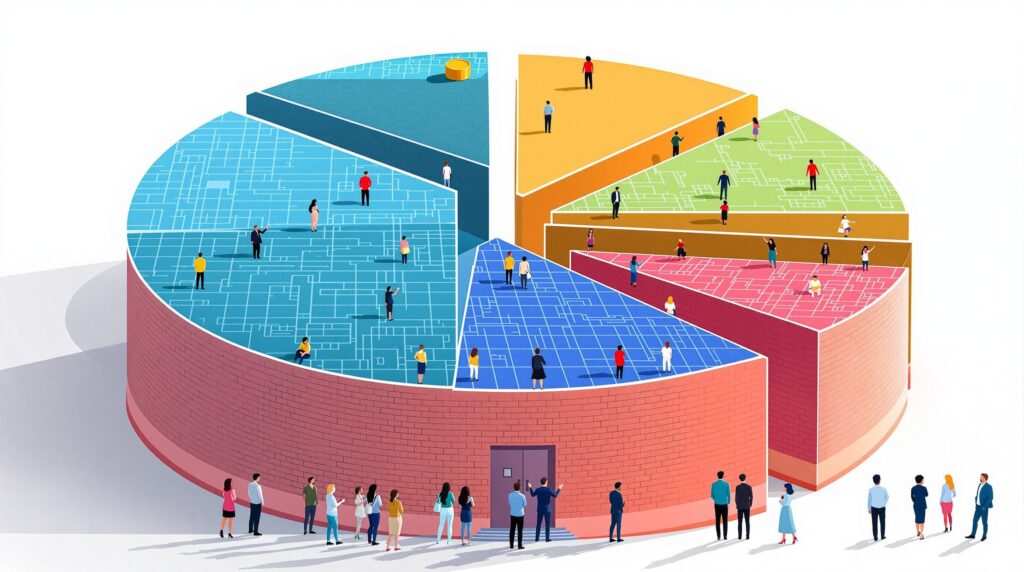[rev_slider alias=”slider-1″][/rev_slider]
Understanding Layer 1 Blockchain Foundations
Layer 1 blockchains serve as the backbone of many cryptocurrency systems. But what exactly are they, and why are they so important? At their core, they are the primary architecture upon which all other blockchain features and improvements are built. Imagine them as the highways of the digital world, carrying data and transactions swiftly across the network. By understanding Layer 1 blockchain systems, you not only grasp the canvas upon which vibrant digital economies like Africa’s $200 billion digital asset market are drawn, but also see how they facilitate efficient and secure transactions. The firm architecture of these blockchains anchors the entire ecosystem, ensuring that every single transaction is validated and stored on the main chain.
Key Features of Layer 1 Blockchains
Layer 1 blockchains boast several essential characteristics that ensure their effectiveness and reliability:
- Decentralization: This is a core feature that allows these blockchains to operate without a central governing authority. By spreading transaction validation across numerous nodes globally, Layer 1 blockchains effectively prevent double-spending and ensure the integrity of transactions.
- Security: Robust cryptographic techniques underpin the security of Layer 1 blockchains. By employing complex mathematical puzzles, these systems safeguard against fraudulent activities and unauthorized access, making them incredibly secure.
- Scalability: Although historically challenging, current innovations are pushing the limits of Layer 1’s throughput capabilities. This ensures blockchains can accommodate growing user demands without compromising performance.
These features are not just technical metrics; they lay the groundwork for innovations such as cross-chain interoperability, enabling different blockchains to communicate and transact with one another, much like how different nations trade through shared protocols and agreements.
How does a Layer 1 blockchain support cross-chain interoperability? By providing a secure and decentralized foundation, Layer 1 blockchains facilitate the building of bridges between distinct blockchain ecosystems.
The role of Layer 1 blockchains in the defense of cryptocurrency systems cannot be overstated. These blockchains do not just store data; they enable innovations that connect varying digital assets, even as Africa steps confidently into the digital age with pioneering efforts led by platforms like Jara. Jara, in particular, capitalizes on these foundational structures by leading initiatives like the tokenization of real-world assets through its unique ecosystem.
The link between Layer 1 blockchains and platforms like Jara is crucial. By understanding this connection, investors and users alike can make more informed decisions about their role in the digital economy’s future.
In the evolving landscape of blockchain, understanding these key pillars of Layer 1 technologies helps demystify the complexity of digital asset management. As Africa’s infrastructure evolves, and as investments in these technologies deepen, platforms such as Jara exemplify how leveraging these foundations can lead to economic empowerment and substantial growth across the continent.
The Role of Layer 1 Blockchains in Cross-Chain Interoperability
Layer 1 blockchains play a pivotal role in enabling cross-chain interoperability, which is essential for the seamless interaction and communication between different blockchain networks. These foundations are at the heart of decentralized networks, offering the infrastructure needed to support complex transactions and data exchanges across various chains. With blockchain technology evolving rapidly, understanding how Layer 1 solutions facilitate interoperability is key to leveraging their full potential.
Cross-Chain Communication Mechanisms
When it comes to cross-chain communication, several mechanisms have emerged that are utilized by Layer 1 blockchains to facilitate interoperability. Let’s dive into the major ones:
- Atomic Swaps: Atomic swaps enable the direct exchange of cryptocurrencies between different blockchains without relying on a centralized intermediary. This trustless exchange method ensures that both parties fulfill their obligations before a transaction is completed, reducing the risk of fraud.
- Blockchain Bridges: Blockchain bridges connect two separate blockchains, allowing for the transfer of assets and data between them. These bridges have become a cornerstone in creating a more interconnected blockchain ecosystem.
What is Cross-Chain Interoperability? Cross-chain interoperability refers to the ability of different blockchain networks to communicate and exchange information or assets with one another, enhancing their usability and effectiveness across diverse platforms.
As we delve deeper into the topic, it’s worth noting that each of these mechanisms brings unique advantages and challenges. For instance, atomic swaps require sophisticated smart contracts to function efficiently, while blockchain bridges must be designed with security in mind to prevent vulnerabilities.
Interoperability Protocols and Technologies
Interoperability protocols and technologies are the backbone of cross-chain compatibility. These protocols provide the rules and standards by which different blockchain networks can communicate. Some popular protocols include:
- Polkadot: Known for its parachain technology, Polkadot allows multiple chains to operate together cohesively, sharing security and interoperability.
- Cosmos: This blockchain protocol uses the Tendermint consensus engine to enable scalability and interoperability across blockchains.
- Interledger Protocol (ILP): ILP allows for the seamless transfer of money between different ledgers or payment networks, making it a crucial tool for cross-chain interoperability.
Why is Cross-Chain Interoperability Important? It allows for a dynamic and integrated blockchain ecosystem where different platforms can share resources, increase liquidity, and improve scalability and user experience.
The continued development of these protocols emphasizes the need for seamless and secure interactions among various blockchain networks, thereby expanding possibilities within the digital economy. With the backing of strong interoperability measures, projects like Jara can leverage these technologies to fuel Africa’s digital asset economy effectively.
In the context of Africa, the integration of these technologies can significantly enhance financial inclusion. By harnessing the power of Layer 1 blockchains, platforms can overcome infrastructure limitations and enable broader access to digital economies. This set of tools and protocols opens up new opportunities, turning the vision of a connected, efficient blockchain ecosystem into reality.
“Your Voice, Our Mission” – we champion your rights with the tenacity and dedication that has earned us the trust of our community members.
Stay tuned as we continue to explore how Jara and its groundbreaking technologies are bridging global capital to African assets, revolutionizing the way digital economies are built and accessed. Through effective use of cross-chain interoperability, Jara aims to redefine the horizons of financial technology and bring Africa’s digital asset ecosystem into the global spotlight.
Learn more about how Jara is empowering Africa’s digital revolution by visiting our website.
[rev_slider alias=”text-call-cta”][/rev_slider]
Comparing Layer 1 and Layer 2 Blockchain Solutions
In the expansive universe of blockchain technology, distinguishing between Layer 1 and Layer 2 solutions is essential to understanding how they enhance scalability and efficiency. But what exactly separates these two layers, and how do they complement each other to provide a more robust framework for blockchain innovations?
What is a Layer 1 blockchain? A Layer 1 blockchain refers to the base level of a blockchain architecture, which includes the fundamental components such as consensus mechanisms, data structures, and network protocols. It serves as the primary network where transactions are executed and recorded.
Layer 1 blockchains, such as Bitcoin and Ethereum, form the core architecture of decentralized systems. They handle basic features like consensus algorithms—Proof of Work (PoW) and Proof of Stake (PoS)—alongside security and infrastructure elements. Yet, despite their foundational role, Layer 1 solutions often face challenges related to scalability. As transaction volumes increase, so do network loads, leading to slower processing speeds and higher costs.
Enter Layer 2 solutions, designed as enhancements to the existing Layer 1 architecture. They aim to tackle the limitations of Layer 1 by offloading transactions onto a separate layer, thus easing the burden on the base blockchain. Prominent examples include the Lightning Network for Bitcoin and Rollups for Ethereum, which enable faster transaction processing and reduced fees.
How do Layer 2 solutions work with Layer 1? Layer 2 solutions operate above the primary blockchain, facilitating off-chain transactions that are later batched and incorporated into the Layer 1 blockchain, thereby enhancing scalability without compromising security.
Now, you might wonder, how do these layers work together in practice? Consider them as two gears in a well-oiled machine. While Layer 1 provides the fundamental operating framework, Layer 2 acts as an accelerator. By handling smaller, frequent transactions off-chain, Layer 2 significantly alleviates congestion on Layer 1, propelling overall system efficiency and utilization.
Why are Layer 2 solutions necessary? They enable higher throughput and cost-effective transactions by processing a large number of off-chain transactions, which are settled on the Layer 1 blockchain, ensuring security and consensus integrity.
Use Cases for Layer 1 and Layer 2 Solutions
How do these layers manifest in real-world scenarios? Consider Africa’s burgeoning market, Jara illustrates the synergy between these solutions in Africa’s digital asset economy. Through its proprietary Caldera-based Layer 2 blockchain, Jara enhances the transactional efficiency of high-demand assets like the Lagos airport tokenization project.
- Financial Inclusion: In regions where access to banking services is limited, Layer 2 solutions empower financial inclusivity by facilitating micro-transactions and peer-to-peer transfers with minimal fees, crucial for emerging markets.
- Decentralized Applications (dApps): Supporting dApp ecosystems on platforms like Ethereum can be made more efficient with Layer 2 solutions, where high transaction volumes don’t compromise speed or cost. Jara’s ecosystem exemplifies this with its AI-powered influencer mechanisms and social-first wallet.
- Tokenized Assets: The seamless trade of tokenized real-world assets on Layer 1, complemented by Layer 2’s rapid transaction processing, enriches investment opportunities across Africa, underpinning Jara’s strategic projects.
- Gaming & Content Platforms: These platforms benefit immensely from Layer 2 scalability, supporting vast volumes of interactions without slowing down the network, echoing Jara’s emphasis on social integration.
As the blockchain landscape evolves, understanding and leveraging the complementary strengths of Layers 1 and 2 is pivotal for optimizing both performance and user experience. It’s a dynamic dance of digital functionality, where Layer 1 sets the stage and Layer 2 adds the flair, paving the way for Africa’s digital revolution.
Future Trends in Layer 1 Blockchain Interoperability
With the rapid advancements in technologies surrounding blockchain, Layer 1 blockchain networks are constantly evolving to enhance cross-chain interoperability. This evolution is critical as it facilitates seamless and efficient communication between different blockchain networks, thus driving the expansion of the blockchain ecosystem worldwide. What emerging trends are shaping the future of Layer 1 blockchain interoperability? Let’s delve into some of the most promising advancements.
Decentralized Finance (DeFi) Integration
DeFi is reshaping the financial landscape by replacing traditional financial systems with decentralized alternatives. As more Layer 1 blockchains support cross-chain transactions, DeFi platforms are becoming increasingly interconnected, offering users more options to lend, borrow, and trade assets across different chains without relying on centralized intermediaries. This emerging trend of multi-chain DeFi platforms is expected to revolutionize how users engage with financial services, particularly in cryptocurrency and blockchain technologies.
Scalability Solutions
One of the primary challenges of blockchain technology is scalability. Recent developments in Layer 1 scalability solutions, such as sharding, are designed to enhance the transaction throughput of blockchain networks without sacrificing decentralization or security. These solutions will pave the way for more efficient cross-chain interoperability, potentially supporting the exponential growth of applications across large networks. You might wonder, how do these solutions impact scalability? Sharding allows a blockchain to process multiple transactions simultaneously by dividing the network into smaller partitions, each processing its own transactions and smart contracts.
Quantum-Resistant Algorithms
As we move forward, the advent of quantum computing presents both opportunities and challenges to blockchain technology. While quantum computing can efficiently solve complex problems currently beyond the reach of classical computers, it also poses a threat to the cryptographic security that blockchain relies on. Future-proofing Layer 1 blockchains involves developing quantum-resistant algorithms, ensuring that these networks maintain security even as quantum technology becomes more prevalent.
What is Quantum Resistance in Blockchain? Quantum resistance refers to cryptographic algorithms that remain secure against attacks by quantum computers, which are capable of solving certain mathematical problems much faster than classical computers.
Interoperability Protocols and Standards
The future of blockchain will see the development of standardized protocols that enable seamless interoperability between different Layer 1 blockchains. Protocols like Polkadot’s interoperability framework allow for secure message passing and data transfer between disparate blockchain networks, enhancing their ability to operate together. As these protocols mature, they will support a broader range of applications and use cases across various chains, ultimately benefiting the global blockchain and legal systems.
“The true power of blockchain technology lies in its ability to create a seamless ecosystem where different networks can communicate and share data efficiently.”
Impact on Global Blockchain Networks
As Layer 1 blockchains enhance their interoperability, the impact on global blockchain networks is profound. This enhancement facilitates the creation of a unified digital economy where assets and data can move freely across borders and platforms, unlocking new opportunities for businesses and individuals alike. We foresee financial inclusion becoming more accessible, particularly in emerging markets like Africa, where Jara’s unique ecosystem is transforming how digital assets are engaged with.
Across various sectors, the interoperability of Layer 1 blockchains will empower innovations, fostering economic growth and financial independence. By leveraging these advanced technologies, companies and individuals can engage in trustworthy cross-border transactions, paving the way for a new era of digital commerce.
“Your Voice, Our Mission” – At Jara, we are fully committed to bridging global capital to African assets, harnessing the power of interoperable blockchain technologies to create a thriving digital economy.
In conclusion, the future trends in Layer 1 blockchain interoperability suggest a dynamic landscape where decentralized finance, scalability solutions, quantum resistance, and interoperability protocols coalesce. This evolution signifies a substantial progression towards an interconnected digital world. As these advancements unfold, they hold the potential to redefine the global economic fabric, making a robust case for embracing blockchain technology as a transformative force.
[rev_slider alias=”schedule-consultation-btn”][/rev_slider]


Related Practice Areas
Explore additional related pages that enhance your understanding of Layer 1 blockchain functionalities and their applications across various sectors.
Discover What Our Clients Are Saying
At the forefront of our Layer 1 blockchain solutions practice is a deep-seated commitment to client satisfaction. Each case is handled with utmost care, as echoed in the appreciative feedback from those we represent.

[rev_slider alias=”slider-3″][/rev_slider]
[rev_slider alias=”slider-6″][/rev_slider]
Experience the Future of Blockchain with Jara
Ready to elevate your blockchain strategy? At Jara, we are at the forefront of integrating Layer 1 and Layer 2 solutions to streamline cross-chain interoperability. With our wealth of expertise and cutting-edge technologies, we’re committed to helping you unlock the full potential of blockchain for your business.
Join us and experience firsthand the innovative power of blockchain technology. Download the Jara app today!
Our Recognitions
| Award | Organization | Year | Criteria |
|---|---|---|---|
| Top Blockchain Innovators in 2023 | InnovateTech | 2023 | Recognizing breakthrough technologies in blockchain. |
| Leading Blockchain Solution Providers | TechFuture Awards | 2023 | Acknowledging high-impact innovations in blockchain systems. |
| Blockchain Excellence Award | Financial Times | 2023 | Honoring leaders in blockchain technological advancement. |
| Top Cross-Chain Innovators | InterChain Connect | 2023 | Celebrating pioneers in cross-chain interoperability. |
| Blockchain Visionary Award | VisionTech Inc. | 2023 | Recognizes trailblazers in blockchain vision and execution. |
But don’t just take our word for it. Reach out to Jara today and witness our expertise in action. Our innovative solutions are designed to adapt to the dynamic demands of the global blockchain landscape, ensuring seamless integration and maximum efficiency for your enterprise.
Chinyere “Chi” Nnadi Bio
Founder and CEO, Jara | Blockchain Interoperability Specialist
Content Reviewed by Chi Nnadi and his Content Team. Chi is an experienced entrepreneur dedicated to innovatively advancing Africa’s financial ecosystem through blockchain technology. As the visionary behind Jara, he builds enterprise-grade infrastructure converting Africa’s illiquid assets into globally accessible digital tokens. With his proprietary Layer-2 blockchain technology and expertise in cross-chain interoperability, Chi bridges the gap between global investors and Africa’s burgeoning digital asset market.
Our Content Review Process
Chi Nnadi along with Jara’s dedicated content team, pledges to provide exceptional material quality. Our content guidelines guarantee thoroughness, utilize reputable sources, conduct unbiased reviews, and implement other rigorous quality metrics. Feel free to reach out if you identify any inaccuracies.
















